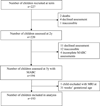Neonatal white matter abnormality predicts childhood motor impairment in very preterm children
- PMID: 22014319
- PMCID: PMC4040368
- DOI: 10.1111/j.1469-8749.2011.04095.x
Neonatal white matter abnormality predicts childhood motor impairment in very preterm children
Abstract
Aim: Children born very preterm are at risk for impaired motor performance ranging from cerebral palsy (CP) to milder abnormalities, such as developmental coordination disorder. White matter abnormalities (WMA) at term have been associated with CP in very preterm children; however, little is known about the impact of WMA on the range of motor impairments. The aim of this study was to assess whether WMA were predictive of all levels of motor impairments in very preterm children.
Method: Two hundred and twenty-seven very preterm infants (< 30 wks gestational age or birthweight < 1250 g) had brain magnetic resonance imaging at term-equivalent age to assess for WMA, which were categorized as nil, mild, or moderate to severe. At 5 years of age children were classified as having a moderate to severe motor impairment if they were below the 5th centile or mild to severe motor impairment if their score placed them no higher than the 15th centile on the Movement Assessment Battery for Children (MABC). WMA (nil vs mild and nil vs moderate-severe) were explored as predictors of motor impairment using logistic regression. Analyses were repeated adjusting for the effects of other perinatal variables and excluding children with CP.
Results: Of the 193 very preterm children (97 males, 96 females) assessed with the MABC, 53 (27%) were classified as having a moderate to severe motor impairment and 96 (50%) a mild to severe motor impairment. WMA were predictive of motor impairment in very preterm children, with mild versus no WMA increasing the odds of moderate to severe motor impairment by over fivefold (odds ratio [OR] 5.6; 95% confidence interval [CI] 1.9-16.1; p=0.002) and mild to severe impairment by twofold (OR 2.2; 95% CI 1.1-4.2; p=0.02). Compared with no WMA, moderate to severe WMA increased the odds for moderate to severe impairment 19-fold (OR 19.4; 95% CI 5.6-66.7; p<0.001) and for mild to severe motor impairment ninefold (OR 9.4; 95% CI 3.2-28.1; p<0.001). Results remained similar after controlling for several potential confounders and after excluding 14 children who had CP at age 2 years.
Interpretation: WMA predict motor impairment at 5 years, with rates of impairment increasing with more severe WMA. Very preterm children with any WMA at term require follow-up throughout childhood.
© The Authors. Developmental Medicine & Child Neurology © 2011 Mac Keith Press.
Figures
Comment in
-
Images, brains, and number games.Dev Med Child Neurol. 2011 Nov;53(11):972-3. doi: 10.1111/j.1469-8749.2011.04118.x. Dev Med Child Neurol. 2011. PMID: 22014315 No abstract available.
References
-
- Himpens E, Van den Broeck C, Oostra A, Calders P, Vanhaesebrouck P. Prevalence, type, distribution, and severity of cerebral palsy in relation to gestational age: a meta-analytic review. Dev Med Child Neurol. 2008;50:334–340. - PubMed
-
- Williams JW, Lee KJ, Anderson PJ. Prevalence of motor-skill impairment in preterm children who do not develop cerebral palsy: a systematic review. Dev Med Child Neurol. 2010;52:232–237. - PubMed
-
- American Psychiatric Association. Diagnostic and Statistical Manual of Mental Disorders, 4th edn, Text Revision, (DSM-IV-TR) Arlington, VA: American Psychiatric Association; 2000.
-
- Salt A, D’Amore A, Ahluwalia J, et al. Outcome at 2 years for very low birthweight infants in a geographical population: risk factors, cost, and impact of congenital anomalies. Early Hum Dev. 2006;82:125–133. - PubMed
Publication types
MeSH terms
Grants and funding
LinkOut - more resources
Full Text Sources
Medical
Miscellaneous


